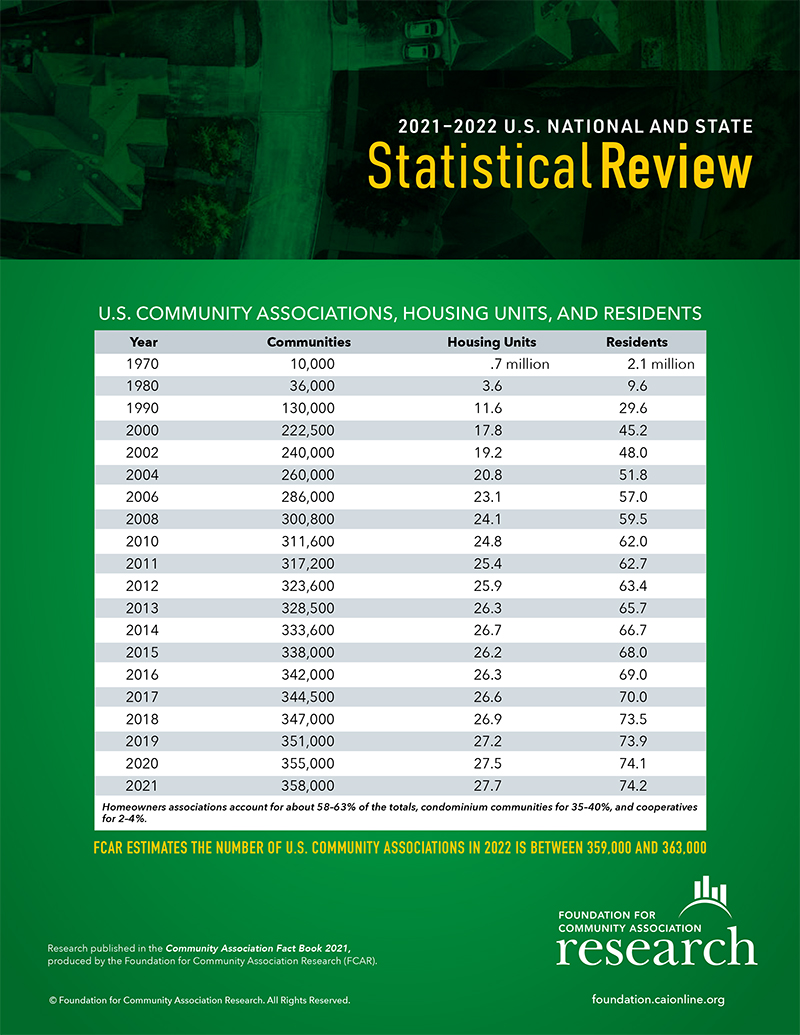 Boston, MA Condominium communities and homeowners associations continue to be a popular form of housing for many Americans, according to a report published in 2022 by the Foundation for Community Association Research. The 2021-2022 U.S. National and State Statistical Review for Community Association Data showed that 74.2 million Americans, or roughly 28% of the U.S. population, now live in a homeowners association, condominium community, or housing cooperative, collectively referred to as community associations or planned communities.
Boston, MA Condominium communities and homeowners associations continue to be a popular form of housing for many Americans, according to a report published in 2022 by the Foundation for Community Association Research. The 2021-2022 U.S. National and State Statistical Review for Community Association Data showed that 74.2 million Americans, or roughly 28% of the U.S. population, now live in a homeowners association, condominium community, or housing cooperative, collectively referred to as community associations or planned communities.
Numbers by State
There were around 358,000 community associations in the U.S. as of 2021 and it was estimated that the number of U.S. community associations in 2022 ranged between 359,000 and 363,000.
Homeowners associations accounted for 58%–63% of the total, followed by condominium communities with 35%–40%, and cooperatives at 2%–4%.
According to the report, California leads the nation with 50,010 associations, home to 14.3 million residents. Florida has the second-most with 49,420, followed by Texas (21,680), Illinois (19,010), North Carolina (14,440), New York (14,170), and Massachusetts (11,230) with Connecticut further down the list with 5,000 associations. New Hampshire is estimated to have between 2,000 and 3,000 associations followed by Maine, Rhode Island and Vermont with between 1,000 and 2,000 associations in each of those states.
Community associations have been growing consistently and successfully for decades. The overwhelming majority (89%) of homeowners and condominium association residents rate their overall experience living in a community association as “very good” (38%), “good” (28%), or “neutral” (23%), according to the 2022 Homeowner Satisfaction Survey, also produced by the Foundation.
Trends and Growth
In the wake of the June 24, 2021, partial collapse of Champlain Towers South condominium in Surfside, FL, industry experts say a new focus on healthy reserve funds is essential for community associations. The 2022 Foundation report showed that about $26.6 billion in assessments are contributed to association reserve funds for the repair, replacement, and enhancement of common property, e.g., replacing roofs, resurfacing streets, repairing swimming pools and elevators, meeting new environmental standards, and implementing new energy-saving features. Estimates showed the value of homes in community associations was nearly $11 trillion.
The report also details top reasons for the growth of community associations:
• The value of collective management. Americans largely have accepted the collective management structure of community association living, where association boards are made up of democratically elected homeowners who voluntarily serve their communities. The research shows there are 2.5 million community association board and committee members in the U.S. performing 98.5 million hours of volunteer service annually.
• Privatizing public functions. With many local municipalities facing fiscal challenges, communities often are developed with the stipulation that the builder create an association that will assume many responsibilities that traditionally belonged to local and state governments (e.g., road maintenance, snow and trash removal, and storm water management). According to the report, 78% of new housing built for sale is in a community association–with homeowners contributing $106.4 billion in assessments to fund essential maintenance.
• Expanding affordable housing. There has been a consistent effort to increase the percentage of homeowners in the U.S., and since the 1960s, condominiums have served as lower-cost entry housing, especially for first-time homebuyers. Condominium communities account for 35%–40% of the reported total of community associations.
For more than 40 years, the Foundation has published the U.S. National and State Statistical Review for Community Association Data as part of the Community Association Fact Book. The report is the only one of its kind–using American Community Survey and American Housing Survey data to better align state-level community association research.
Since its inception, the Foundation’s Statistical Review has been sourced by community association stakeholders such as homeowners, board members, and management professionals as well as attorneys, accountants, developers, mortgage lenders, federal agencies, and public officials—all who work with the Foundation and Community Associations Institute (CAI) to build better communities.
To view the full report, visit foundation.caionline.org.
 (1).png)







